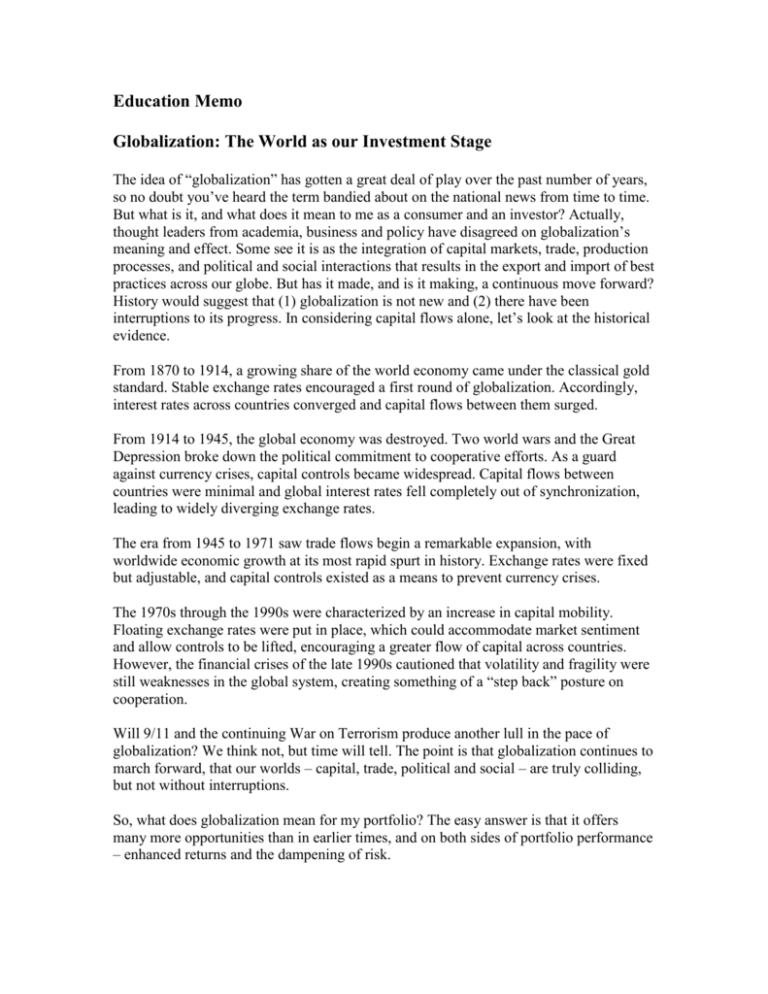Education Memo - The Rainier Group
advertisement

Education Memo Globalization: The World as our Investment Stage The idea of “globalization” has gotten a great deal of play over the past number of years, so no doubt you’ve heard the term bandied about on the national news from time to time. But what is it, and what does it mean to me as a consumer and an investor? Actually, thought leaders from academia, business and policy have disagreed on globalization’s meaning and effect. Some see it is as the integration of capital markets, trade, production processes, and political and social interactions that results in the export and import of best practices across our globe. But has it made, and is it making, a continuous move forward? History would suggest that (1) globalization is not new and (2) there have been interruptions to its progress. In considering capital flows alone, let’s look at the historical evidence. From 1870 to 1914, a growing share of the world economy came under the classical gold standard. Stable exchange rates encouraged a first round of globalization. Accordingly, interest rates across countries converged and capital flows between them surged. From 1914 to 1945, the global economy was destroyed. Two world wars and the Great Depression broke down the political commitment to cooperative efforts. As a guard against currency crises, capital controls became widespread. Capital flows between countries were minimal and global interest rates fell completely out of synchronization, leading to widely diverging exchange rates. The era from 1945 to 1971 saw trade flows begin a remarkable expansion, with worldwide economic growth at its most rapid spurt in history. Exchange rates were fixed but adjustable, and capital controls existed as a means to prevent currency crises. The 1970s through the 1990s were characterized by an increase in capital mobility. Floating exchange rates were put in place, which could accommodate market sentiment and allow controls to be lifted, encouraging a greater flow of capital across countries. However, the financial crises of the late 1990s cautioned that volatility and fragility were still weaknesses in the global system, creating something of a “step back” posture on cooperation. Will 9/11 and the continuing War on Terrorism produce another lull in the pace of globalization? We think not, but time will tell. The point is that globalization continues to march forward, that our worlds – capital, trade, political and social – are truly colliding, but not without interruptions. So, what does globalization mean for my portfolio? The easy answer is that it offers many more opportunities than in earlier times, and on both sides of portfolio performance – enhanced returns and the dampening of risk. Intuitively we know, and history proves, that not all economies of the world are in decline (recession) or expansion at the same time. The same is true of the world’s financial markets. One need only look at the rapid pace of economic growth that Japan experienced in the 1980s, which led to record-setting gains in the Nikkei Average that far surpassed those of any other developed nation during that time period. Similar success stories are taking shape today in the emerging economies of Eastern Europe, India, Brazil, and especially China. On the heels of Japan’s 80s largesse, however, came a 10year period of deflation that had Japan sitting on the sidelines while most of the rest of world’s markets were blessed with strong bull market moves. This still holds true today. While the U.S. equities markets, for instance, have been in a bull phase since 2003, Japan has simply not participated to any real degree. We could name numerous other combinations of countries and time periods to illustrate these disparities, but you get the point. The U.S. markets and the developed and emerging markets overseas are imperfectly correlated to one another, meaning their return patterns aren’t the same. Because this is true, it makes sense to have exposure to all -- or more practically, most -of the markets across the globe. Within the “appreciation engine” of a portfolio, we advocate having strategic exposure to both developed and emerging equities markets overseas, alongside a core position in U.S. equities. Because we believe correlation-related divergences also exist between large, mid and small cap equities in overseas markets, just like they do in the U.S., we also believe in having exposure to all three capitalization sectors within our overseas holdings. To illustrate the power of global diversification, just look at the divergence of returns across the various equity markets of the world year-to-date: U.S. Large Cap Value U.S. Large Cap Growth U.S. Mid Cap Value U.S. Mid Cap Growth U.S. Small Cap Value U.S. Small Cap Growth International Large Cap International Small/Mid Cap Emerging Markets 7.32% 8.14% 9.90% 12.31% 7.16% 10.49% 10.72% 14.99% 17.71% The factors driving attractive performance in the overseas markets include healthy economies, strong corporate earnings, improving regulatory environments, and a compelling foreign exchange environment. Inflation, which is usually a big concern in emerging markets, has remained under control. Strategically, our current portfolio structures call for 30% of equity positions to be positioned in the overseas markets. However, as globalization continues to march forward, don’t be surprised to see us take overseas exposure to higher percentages. Considering that as recently as 2002, when overseas exposure in our clients’ portfolios was less than 10%, we obviously do believe that the WORLD is our oyster. What About China? Anecdotally, 90% of the cranes operating in the world right now are operating in China… and we’ve seen the largest migration of citizens from rural to urban areas in the history of the world there. These phenomena and others have produced a GDP growth rate in that country greater than 10% over each of the past five years, and the Chinese government is doing everything it can to cheer such growth along. Out of this explosive economic growth has come a bull market for the ages. In fact, the Shanghai Composite Index is up more than 50% this year alone, even after three separate corrections, one of which was a 9.8% pullback in a single day. Too frothy? Too volatile? Time to sell? Maybe, maybe not. Let us tell you about two different Chinese markets. The domestic market in China, referred to as the China A-share market, is only available to domestic investors and is denominated in Chinese currency. The Shanghai Composite Index is the benchmark used to measure the performance of this A-share market. The newfound prosperity in the country has drawn more than 80 million retail investors into the market, making up 60-80% of the daily trading volume (unlike the U.S. markets where financial giants like Goldman Sachs and Merrill Lynch dominate trading). The record number of new investors, often with little understanding of market mechanics, has caused the Chinese government to warn of impending trading restrictions. Even so, this market has quadrupled since mid-2005 and is now trading at a lofty P/E ratio of 45 – about 3 times the U.S. P/E. Foreign investors, on the other hand, can access the China market through B-shares, Hshares, Red Chips, or Special Administrative Regions (SARs). These issues are listed in either U.S. or Hong Kong currency. The exchanges that trade in these shares, like the Hang Seng Index, are more prominent and more regulated than those that trade in Ashares. Additionally, these markets are trading at about half the P/E ratio of the A-shares market. Considering the projected earnings growth rates of the companies represented, these markets do not appear overextended. We believe Matthews to be the most talented manager of Asian securities, and their China Fund has been our vehicle of choice for targeted investments in China, accessed through the share classes we just mentioned. Even though the fund is up 40% year-to-date, we still consider it to be an outstanding long-term holding. Having said that, we promised we’d be vigilant in our management of such a targeted investment. As such, we’ll discuss with you the alternatives for taking a portion of our profits off the table, while looking for a re-entry point that either a pullback or time affords us. On a final note, the markets have been kind to portfolios in the first half of the year, even with a several-week correction. We’ll look forward to sharing those positive results with you at our next quarterly review. Until then, Mark Pellegrino Chief Investment Officer Rainier Group Investment Advisory






